School Buildings in 2015: Designing for Students
3. How Students Hear
With educational space planning and movement concerns addressed, we turn our attention to some specific sensory needs of students. In regards to the sense of hearing, the Center for Green Schools/McGraw Hill study of 2012 points out that ample evidence exists showing classrooms can have a negative impact on students' ability to hear, thus clearly making it difficult for them to absorb and retain information. Hence acoustical control of school spaces has appropriately become an important design issue.
A basic acoustical control concern in schools is background noise that can originate from within or outside of the building. Obviously, separating classrooms acoustically whether using fixed or movable walls and doors is a first place to start and has become a part of green building rating systems for schools. For fixed walls or floor/ceiling assemblies, one available strategy is to use noise-reducing gypsum board that is specifically designed to reduce airborne sound transmission between two adjoining spaces.
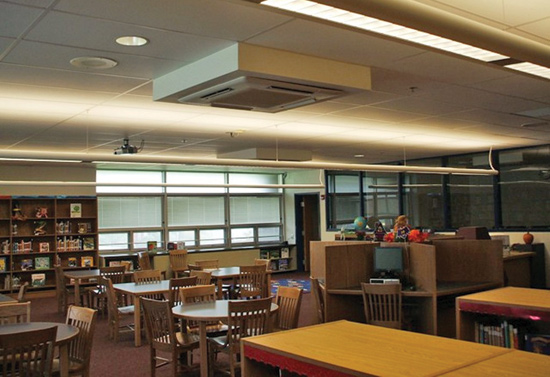

Photos courtesy of Mitsubishi Electric Cooling & Heating and CertainTeed Gypsum
By looking at all aspects of acoustics in a classroom, including quieter HVAC systems, students can hear better, teachers can talk in normal voice tones, and learning is enhanced.
Other acoustical control measures are important as well. For example, noise from outdoors can penetrate exterior walls and windows, making it more difficult for students to hear and for teachers to speak without raising their voices. Addressing the acoustic qualities of exterior walls in the same manner as interior ones will help in this regard. When it comes to windows, a common strategy is to use laminated glass in one or more of the layers of an insulated glass assembly. The laminated glass has been shown to create noise reduction benefits as well as enhancing security in schools.
Within the classroom, background noise can sometimes be generated by mechanical heating or cooling equipment. Selecting such equipment or systems with attention given to the amount of sound generated within the space will be important. Ductless or split systems are available that can deliver comfort without compromising acoustics by operating at decibel levels quieter than a whisper.
4. How Students See
Historically, daylight was used as the predominant source of light for students to see inside school buildings. The energy crisis of the 1970s, however, gave rise to school buildings with few or even no sources of natural light in an effort to reduce heating or cooling energy. Experience has since shown that natural daylight combined with appropriate electrical lighting provides both the right quantity and proper quality of light to enhance learning and academic performance. Further, the positive impacts of natural daylight on student health and performance have been studied and documented in numerous studies showing improvements ranging from slight to significant. One well-known study showed that 8,000 students in grades three through six who learned in fully daylit classrooms demonstrated significantly greater improvement over the course of a school year in standardized test scores than students who were learning in non-daylit classrooms (Heschong Mahone Group, 2003, as cited in “The Benefits of Glass” prepared by the University of Michigan Taubman College of Architecture and Urban Planning in partnership with Guardian Industries Corp.). In a separate study, the California Energy Commission reported learning rates improved 21 percent for 21,000 California elementary school students in classrooms with the most daylight compared to those in classrooms with the least daylight. (October 2003, by New Buildings Institute based on research by Heschong Mahone Group.)

Photo courtesy of Guardian Industries Corp.
Modern glass technology allows abundant daylighting, views, and controllable impacts on energy performance in school buildings.
Better Glass and Glazing
Over the past several decades, glass manufacturers have developed ways to address daylight and energy performance. Rosie Hunter of Guardian Industries Corp. observed, “Today, many different glass products exist to help architects create better learning environments. The days of a row of small windows in classrooms have ended as architects have taken advantage of advancements in glass technology to increase the use of glass in school designs while still addressing energy performance.” By using glass products with varying degrees of visible light transmission and solar heat gain coefficients, architects can use the sun's energy to create a passive heat source in cold climates or to limit solar heat penetration in warmer climates. Hence, energy use and glare can be addressed and balanced to create a positive light quality for students to see and work in.
In addition to daylight, the other beneficial aspect of windows is to facilitate students seeing longer distance views outside of the classroom. Doctors have known that eyestrain and visual acuity problems can develop if students have only short distance views available to them. It is suggested that in order to keep eyes healthy, long distance views are needed. The color of the glass certainly comes into play in this case and many clear, neutral blue, green, and gray colors are available that can enhance specific views, control glare, and generally create desirable visual conditions.
Glass use is not limited to exterior walls, however. Using glass in interior walls is often desirable to allow light and views to be shared from one space to another. In schools, this is problematic when the walls are fire rated. The solution is found in glass that is also specifically formulated to be fire rated and safe. The Safety Glazing Certification Council (SGCC) rates such glass which commonly uses a plastic interlayer laminated between glass outer layers. This combination helps the laminated layers hold together if a glass outer layer is shattered.
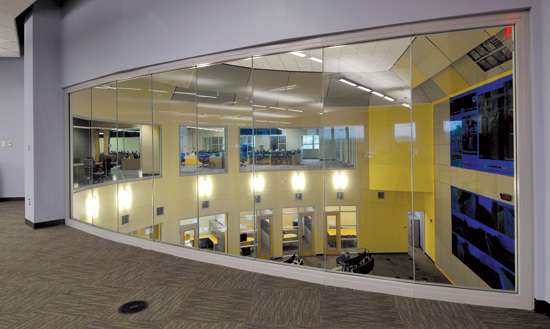
Photo by Lefstead Architectural Photography, courtesy of AGC Glass Company North America
Laminated safety glass, fire-protective glass, and fire-resistive glass all allow light and views to pass through from space to space while meeting a range of fire code and security requirements.
There are further distinctions in the types of fire-rated glass available. Fire-protective glass may be laminated (or use other means) to meet SGCC ratings for safety and fire protection, but it is not a barrier to heat transmission. Fire-resistive glass has an intumescent interlayer which expands at about 250°F to form a rigid and opaque barrier, blocking heat transmission from both convection and radiation. Complete, coordinated glazing systems are available that combine fire-resistive glass with pronounced or minimal frames. There are even butt-glazed solutions that eliminate vertical mullions completely and still provide the needed fire protection. Todd Danciak of AGC Glass Company North America pointed out, “As our society has changed, modern schools are being designed to provide a safer and more secure environment for our children, in addition to a place of learning and enrichment. The proper selection of glass can assure the building occupants of a highly visible, safe, and secure space.”
Glass is also commonly used in stairwells and exterior corridors raising security concerns in schools. Laminated glass and glazing provides a very workable solution since it is able to endure abuse due to interlayers of durable, clear films that keep the glass from breaking apart even when damaged. Further, it fits directly into standard window and glazing frames, making installation very straightforward. Altogether, laminated and fire-resistive glass offers the multiple benefits of code compliance and security enhancement while still allowing light and views to be incorporated into the overall design of school spaces.
Glass Block
In addition to glazed windows, the use of glass block in school buildings has been a recognized strategy to enhance lighting schemes in both exterior and interior walls. Glass block has long been used to help architects design schools that are both creative and sustainable. Among its attributes, glass block provides daylighting with the option of obscuring views or allowing them, which means privacy and transparency can be controlled as desired. Since glass block is thicker than glass, it offers strength against damage or vandalism with surfaces that are easy to clean of graffiti. The make-up of the glass block allows for higher degrees of sound reduction compared to traditional windows. And, similar to glass, fire-rated glass block can be used in fire-rated wall assemblies to allow light to be shared between spaces.
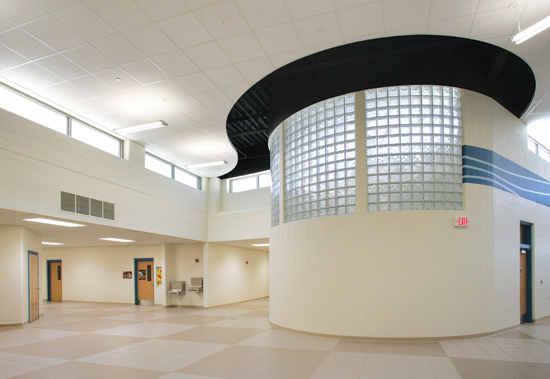
Photo courtesy of Pittsburgh Corning
Glass block can be an integral part of a school design to provide a durable and effective way to provide natural light in a space.
In Hudson, Wisconsin, the 93,450-square-foot River Crest Elementary School took advantage of glass block to enhance the design for 588 students in grades kindergarten through five. Commissioned in 2006, the school was to be a highly sustainable and innovative education center. Glass blocks enabled the designers to meet the prerequisite challenge of acoustics to ensure classrooms are quiet enough for learning while still providing natural light and helping to reduce energy costs. In the final design, glass block was used in three separate areas. First, patterned glass blocks introduce light passing through windows and the main foyer into the guidance office, creating a distinctive design. Second, a different pattern was used in the story area of the library to borrow light from an adjacent window. For symmetry, glass blocks were also used between the story area and the adjacent computer lab. Third, glass block with a ripple pattern was used in the cafeteria to frame the opening to a central platform. In all, glass block proved to be an effective and desirable design strategy to allow light to transfer through spaces while meeting other operational needs.
Electric Lights
As noted earlier, the quality of light is essential just as the quantity of light is in creating better learning environments. Good light quality allows students to see clearly, have a feeling of warmth and comfort, and brings clarity into a space, thus allowing them to think clearly, inspiring their thoughts, ideas, and work. Electric lighting used in conjunction with daylighting, therefore, should be a positive reinforcement to the learning environment. The Illuminating Engineering Society (IES) reinforces this notion in The Lighting Handbook 10th Edition, Section 24.1 – Lighting for Education, where it states, “Knowledge acquisition and the process of learning involve the visual exploration of tangible forms and the discovery of concepts from written and graphical displays on paper, computer, and projection. Lighting's role is fundamental. However, lighting also sets the scene for listening, developing social skills, comprehending situations, and recognizing and understanding places.”
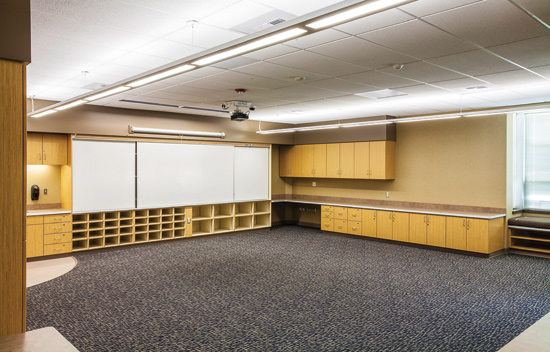
Photo by Joe Nuess, Nuess Photography; courtesy of ELP Lighting
Recessed wall wash fixtures illuminate the white boards while indirect/direct luminaires provide general illumination at Sunset View Elementary School in Kennewick, Washington, designed by MMED Architecture.
In the context of modern classrooms and study spaces, quality lighting is needed not just for general ambient lighting, but also for specific needs related to white boards, wall displays, coves, exterior walkways, video conferencing, or distance learning applications. In order to meet varied needs, fixtures are available specifically for school designs that distribute light in asymmetric or other specific patterns in a variety of fixture shapes, sizes, and energy-efficient lamping options (i.e. LED and fluorescent). This variety means that they can be selected and specified to provide the particular lighting needed for specific situations. For example, in the case of Sunset View Elementary School in Kennewick, Washington, the classrooms are complex in their uses with the availability of many different media that can be used as teaching tools. The classrooms have a white board or smart board on the wall and above is a flat-screen monitor for video reception. While the white/smart boards need to be illuminated, light on the flat screen will wash out the image. Hence, adjustable wall wash fixtures were used to solve this problem by allowing adjustment of the light distribution so there is no light above the top of the white/smart board. Further, for the general area, suspended direct/indirect fixtures were used that provide very good dispersion of light and good light quality overall.
Notice
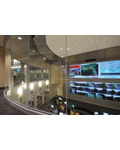
www.pyrosafeglass.com

www.BisonIP.com
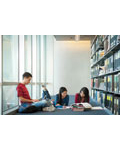
www.certainteed.com/airrenew

www.dorma.com/
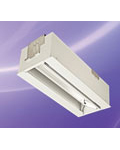
www.elplighting.com/
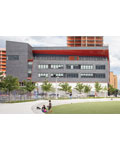
www.endicott.com/
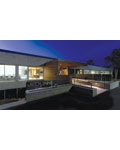
www.SunGuardGlass.com/
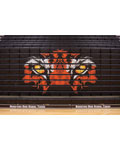
www.husseyseating.com/
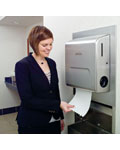
www.kcprofessional.com/
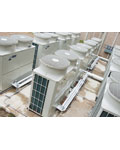
www.MitsubishiPro.com/
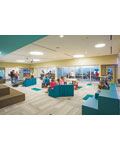
Architect: Hollis + Miller Architects
www.NanaWall.com/
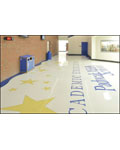
www.ntma.com/
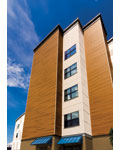
www.nichiha.com/
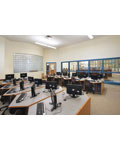
www.pittsburghcorning.com/
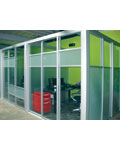
www.spaceplus.com/

www.us-concrete.com/aridus/
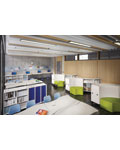
www.vs-network.com/









